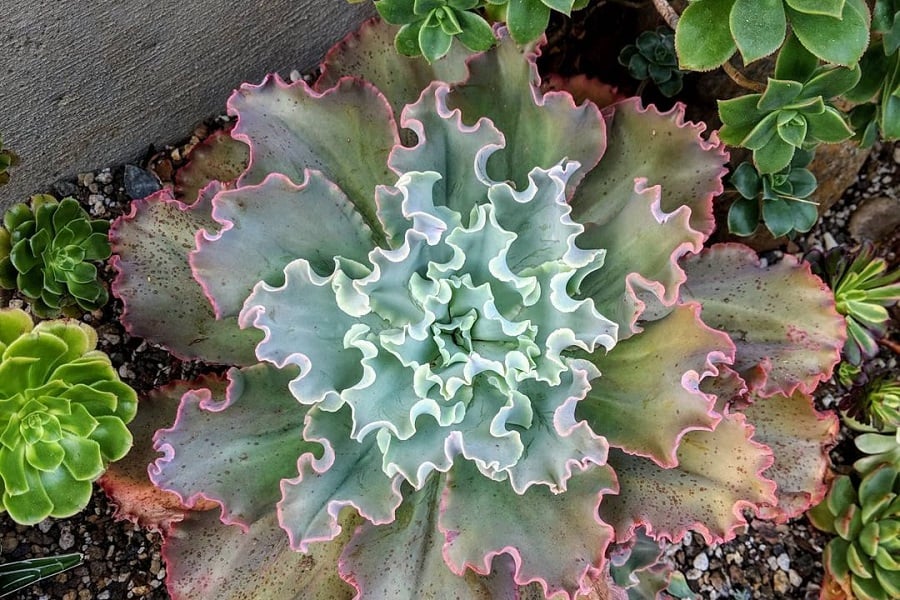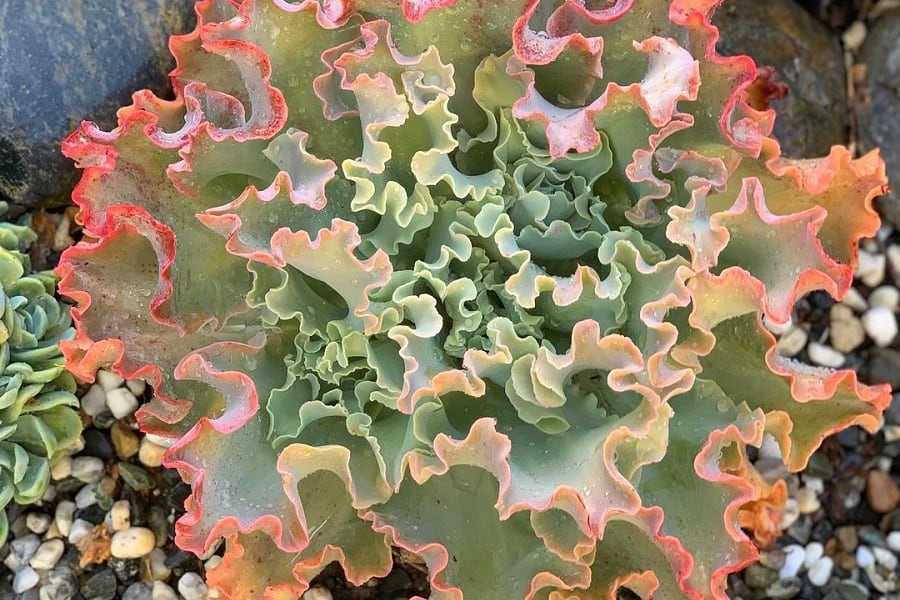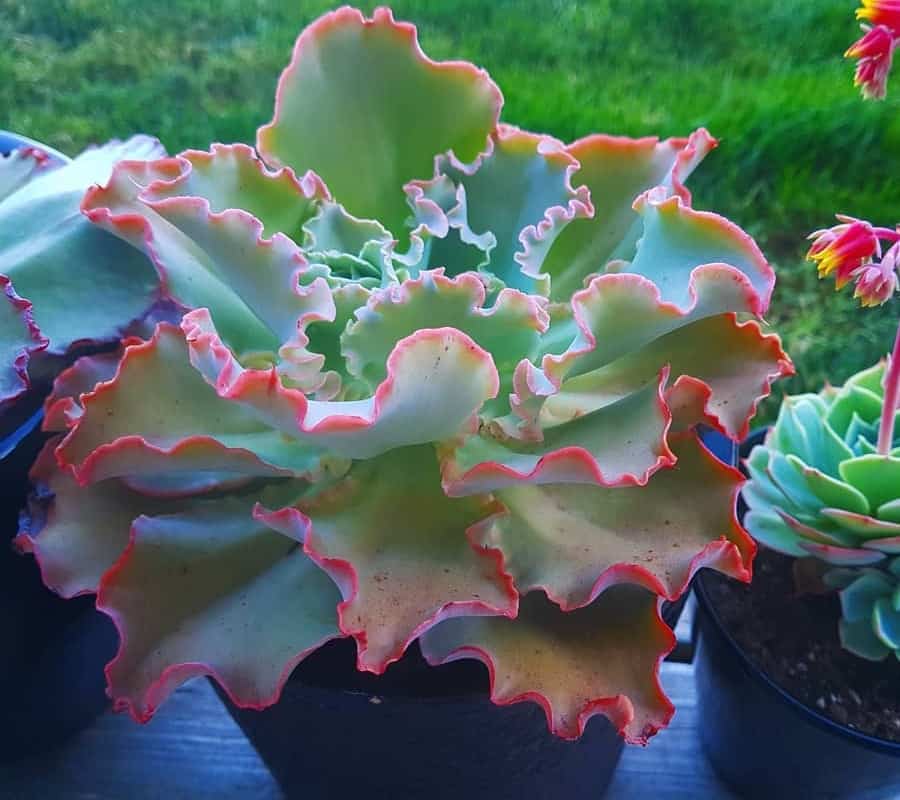Echeveria Giant Blue: The Succulent Sensation You Can’t Resist
Have you ever laid eyes on a succulent so breathtakingly beautiful, it made your heart skip a beat? Introducing the Echeveria Giant Blue, a true gem in the world of succulents. With its large, ruffled rosettes and captivating hues, this succulent is a must-have for any plant lover’s collection.
As the name suggests, the Echeveria Giant Blue boasts massive rosettes that can reach up to 12 inches (30 cm) in diameter. Its fleshy leaves start off a gorgeous blue-green shade, deepening to a rich blue as the plant matures. But that’s not all – the outer edges of the leaves are adorned with a striking pink line, adding an extra touch of whimsy to this already stunning succulent.

Related Post:
160+ Amazing Echeveria Types with Pictures
Contents
Echeveria Giant Blue Care Guide
Light
The Echeveria Giant Blue craves lots of sunlight to truly showcase its vibrant colors. Aim to provide at least 4-5 hours of direct sunlight daily. If you’re growing it indoors, a south-facing window or a grow light will do the trick. Too little light can cause the plant to stretch and lose its compact form.
Water
Like most succulents, the Giant Blue echeveria is drought-tolerant and prefers infrequent but deep watering. Allow the soil to dry out completely before giving it a good soak, ensuring excess water drains away. Overwatering is a surefire way to invite root rot, so err on the side of underwatering.

Soil
The Echeveria Giant Blue craves a well-draining, porous soil mix to prevent waterlogging and root rot. A standard cactus or succulent potting mix from your local nursery or garden center is perfect for this beauty. The gritty texture allows excess moisture to escape while providing the ideal environment for your succulent’s roots to thrive.
Climate
This succulent is a sun-worshipper that loves hot and dry conditions. Indoors, it thrives in temperatures ranging from 65-80°F (18-27°C) during its active growing season (spring and summer). In the winter months, a few degrees cooler around 60-65°F (15-18°C) is ideal. Outdoors, the Echeveria Giant Blue basks in warm summer temperatures of at least 70°F (21°C). Avoid cold drafts and high humidity, as these can lead to rot and other issues.
Fertilizer
While not a strict requirement, you can give your Echeveria Giant Blue an occasional boost with a diluted cactus or succulent fertilizer. During its active growth phase in spring and summer, feed it every 2-3 weeks with a low-nitrogen fertilizer diluted to 1/4 or 1/3 of the recommended strength. This gentle feeding will encourage healthy growth without burning the roots.
Potting and Repotting

When it comes to potting your Giant Blue echeveria, choose a container slightly larger than the root ball to ensure proper drainage. Terracotta or ceramic pots with drainage holes are perfect for this succulent. Repotting is only necessary when the plant has become severely root-bound, typically every 2-3 years. Springtime is the best season for repotting, as the plant is entering its growth phase. Always use a fresh, well-draining succulent mix, and water sparingly after repotting to avoid root rot.
Propagating Your Echeveria Giant Blue
One of the best things about the Echeveria Giant Blue is how easy it is to propagate. Whether you want to share this stunning succulent with friends or simply expand your collection, there are several methods to choose from.
Leaf Cuttings
Leaf propagation is a simple and effective way to create new Echeveria Giant Blue plants. Here’s how:
- Gently twist or cut a healthy leaf from the mother plant.
- Allow the leaf to callous over for 2-3 days by placing it on a dry surface.
- Once calloused, place the leaf on top of a well-draining succulent mix and lightly press it into the soil.
- Keep the soil moist but not waterlogged.
- In a few weeks, you’ll see tiny roots and eventually a new rosette forming.
Stem Cuttings
If your Echeveria Giant Blue has grown a bit leggy, you can propagate from stem cuttings:
- Using a clean, sharp knife, cut off a stem section about 3-4 inches (7-10 cm) long.
- Allow the cutting to callous over for 2-3 days.
- Plant the calloused cutting in a well-draining succulent mix, burying about 1/3 of the stem.
- Water sparingly until roots have formed and new growth appears.
Offsets
Perhaps the easiest method is propagating from offsets, or the “baby plants” that sprout from the mother plant.
- Wait until the offsets are at least 2 inches (5 cm) tall and have developed their own root system.
- Gently twist or cut the offsets away from the mother plant, ensuring you get some roots.
- Plant the offsets in a well-draining succulent mix and water sparingly.
- Within a few weeks, the offsets will establish themselves as independent plants.
No matter which propagation method you choose, the Echeveria Giant Blue is a fast grower and will reward you with stunning new plants in no time!
